NMIH204: A Reflective Analysis of Bullying and Future Actions
VerifiedAdded on 2023/04/03
|8
|1785
|453
Essay
AI Summary
This essay presents a personal reflection on handling a workplace bullying incident, utilizing Gibb’s reflective cycle. The author, acting as a manager, recounts an incident where an employee reported being bullied by a colleague. The reflection covers the description of the event, the manager's feelings, evaluation of the situation, analysis of the response, and a conclusion outlining future actions to prevent similar incidents. Key aspects include the importance of empathy, ethical considerations, and the implementation of anti-bullying policies and training to foster a positive workplace culture. The reflection emphasizes open communication, clear reporting mechanisms, and consistent enforcement of workplace behavior standards to ensure employee safety and well-being. The essay also suggests further counseling for involved parties and a deeper exploration into the root causes of bullying behavior.
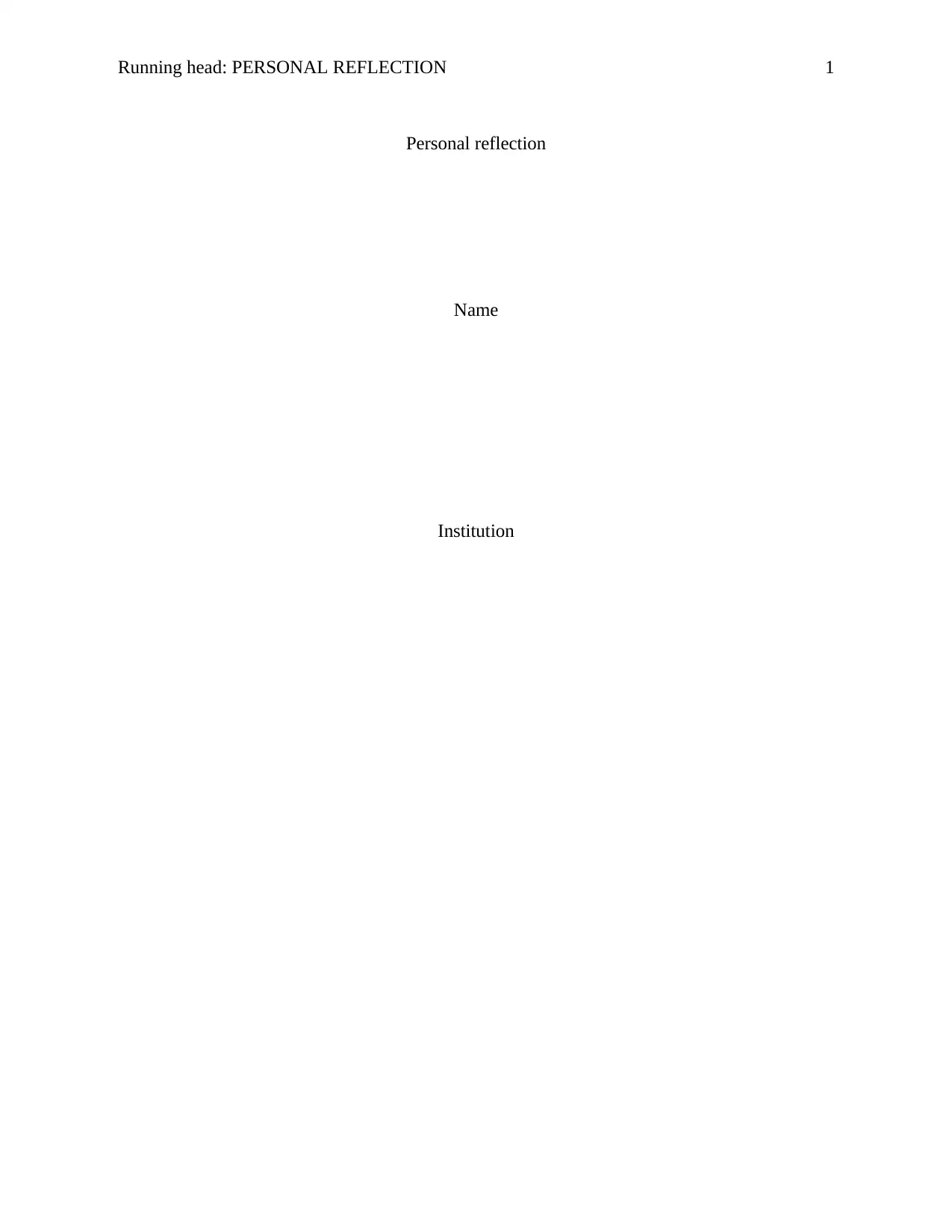
Running head: PERSONAL REFLECTION 1
Personal reflection
Name
Institution
Personal reflection
Name
Institution
Paraphrase This Document
Need a fresh take? Get an instant paraphrase of this document with our AI Paraphraser
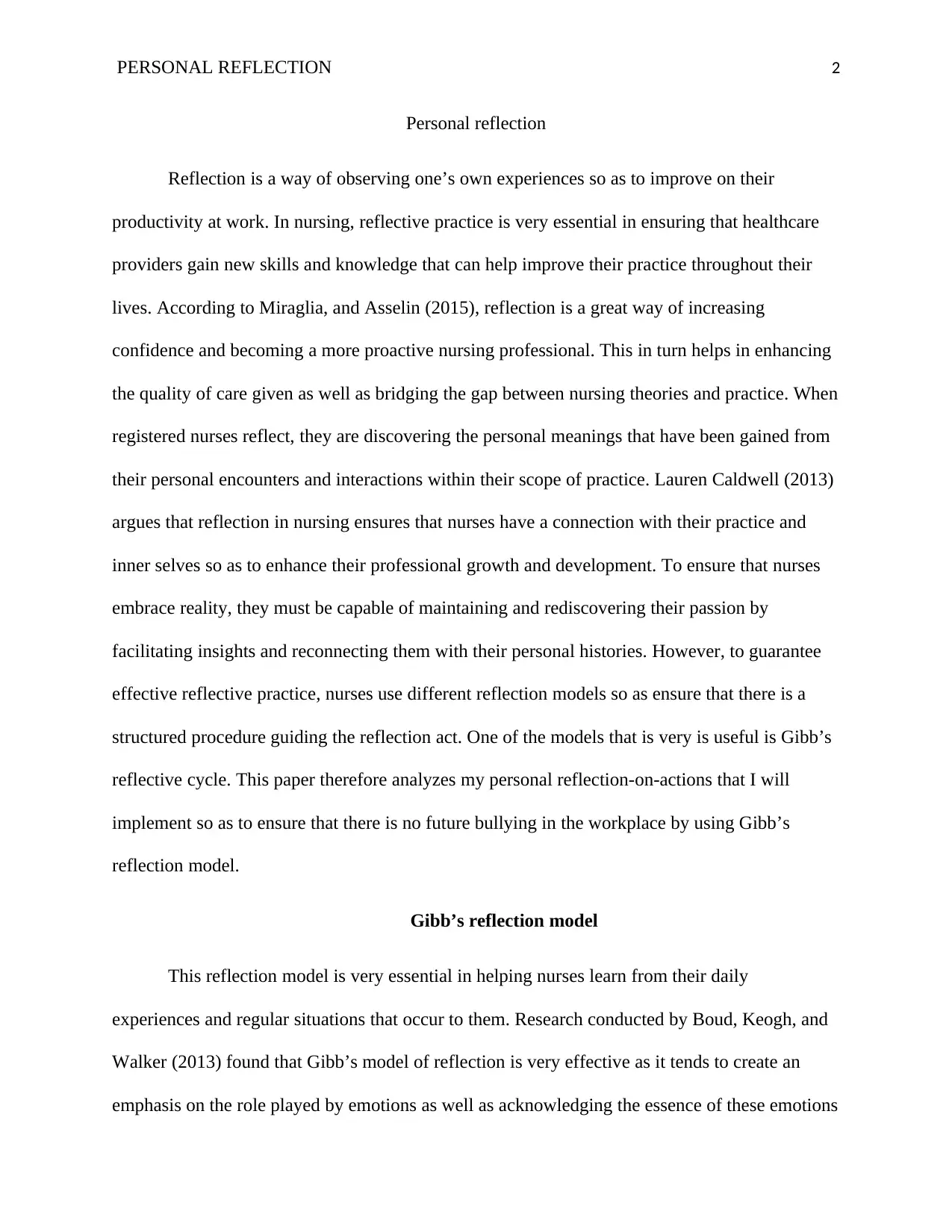
PERSONAL REFLECTION 2
Personal reflection
Reflection is a way of observing one’s own experiences so as to improve on their
productivity at work. In nursing, reflective practice is very essential in ensuring that healthcare
providers gain new skills and knowledge that can help improve their practice throughout their
lives. According to Miraglia, and Asselin (2015), reflection is a great way of increasing
confidence and becoming a more proactive nursing professional. This in turn helps in enhancing
the quality of care given as well as bridging the gap between nursing theories and practice. When
registered nurses reflect, they are discovering the personal meanings that have been gained from
their personal encounters and interactions within their scope of practice. Lauren Caldwell (2013)
argues that reflection in nursing ensures that nurses have a connection with their practice and
inner selves so as to enhance their professional growth and development. To ensure that nurses
embrace reality, they must be capable of maintaining and rediscovering their passion by
facilitating insights and reconnecting them with their personal histories. However, to guarantee
effective reflective practice, nurses use different reflection models so as ensure that there is a
structured procedure guiding the reflection act. One of the models that is very is useful is Gibb’s
reflective cycle. This paper therefore analyzes my personal reflection-on-actions that I will
implement so as to ensure that there is no future bullying in the workplace by using Gibb’s
reflection model.
Gibb’s reflection model
This reflection model is very essential in helping nurses learn from their daily
experiences and regular situations that occur to them. Research conducted by Boud, Keogh, and
Walker (2013) found that Gibb’s model of reflection is very effective as it tends to create an
emphasis on the role played by emotions as well as acknowledging the essence of these emotions
Personal reflection
Reflection is a way of observing one’s own experiences so as to improve on their
productivity at work. In nursing, reflective practice is very essential in ensuring that healthcare
providers gain new skills and knowledge that can help improve their practice throughout their
lives. According to Miraglia, and Asselin (2015), reflection is a great way of increasing
confidence and becoming a more proactive nursing professional. This in turn helps in enhancing
the quality of care given as well as bridging the gap between nursing theories and practice. When
registered nurses reflect, they are discovering the personal meanings that have been gained from
their personal encounters and interactions within their scope of practice. Lauren Caldwell (2013)
argues that reflection in nursing ensures that nurses have a connection with their practice and
inner selves so as to enhance their professional growth and development. To ensure that nurses
embrace reality, they must be capable of maintaining and rediscovering their passion by
facilitating insights and reconnecting them with their personal histories. However, to guarantee
effective reflective practice, nurses use different reflection models so as ensure that there is a
structured procedure guiding the reflection act. One of the models that is very is useful is Gibb’s
reflective cycle. This paper therefore analyzes my personal reflection-on-actions that I will
implement so as to ensure that there is no future bullying in the workplace by using Gibb’s
reflection model.
Gibb’s reflection model
This reflection model is very essential in helping nurses learn from their daily
experiences and regular situations that occur to them. Research conducted by Boud, Keogh, and
Walker (2013) found that Gibb’s model of reflection is very effective as it tends to create an
emphasis on the role played by emotions as well as acknowledging the essence of these emotions
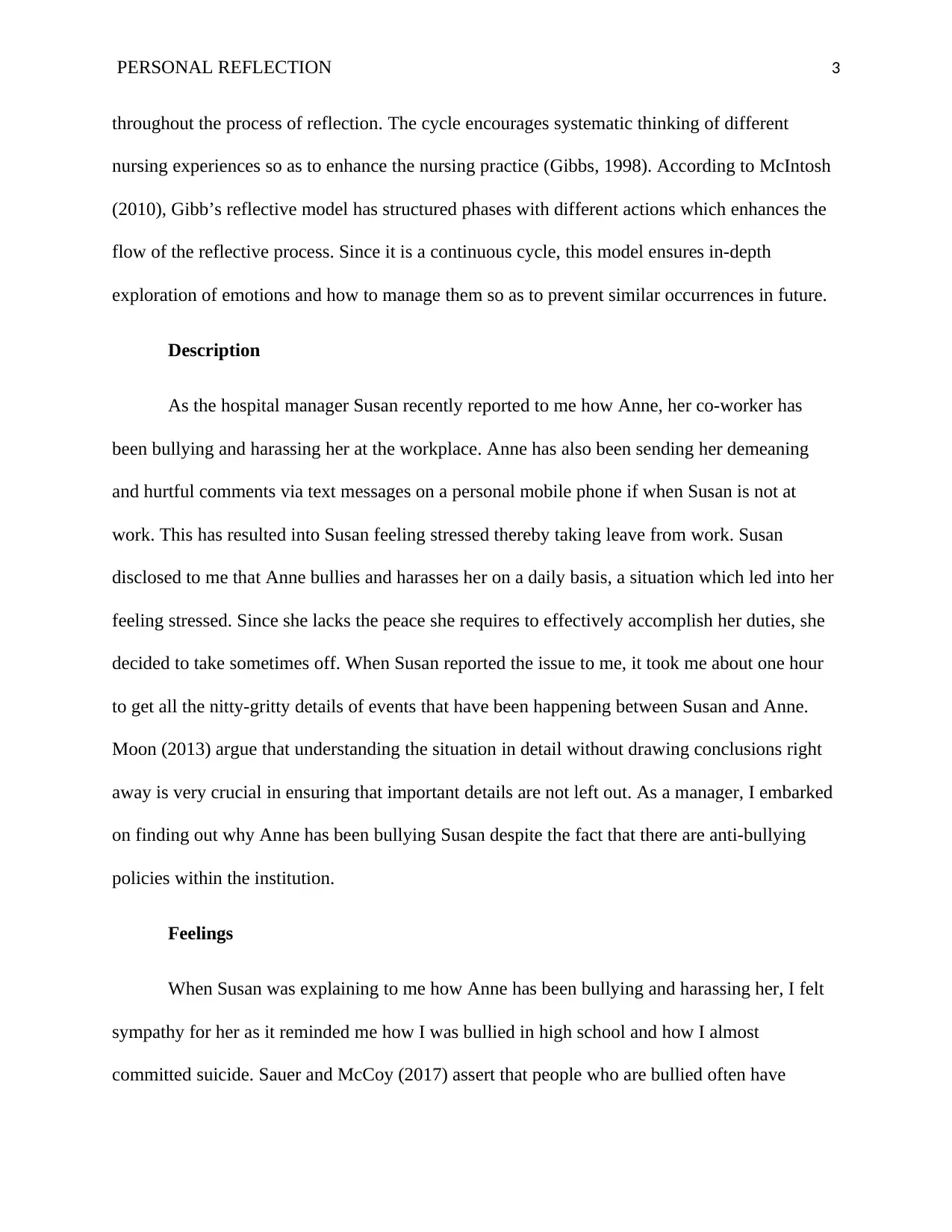
PERSONAL REFLECTION 3
throughout the process of reflection. The cycle encourages systematic thinking of different
nursing experiences so as to enhance the nursing practice (Gibbs, 1998). According to McIntosh
(2010), Gibb’s reflective model has structured phases with different actions which enhances the
flow of the reflective process. Since it is a continuous cycle, this model ensures in-depth
exploration of emotions and how to manage them so as to prevent similar occurrences in future.
Description
As the hospital manager Susan recently reported to me how Anne, her co-worker has
been bullying and harassing her at the workplace. Anne has also been sending her demeaning
and hurtful comments via text messages on a personal mobile phone if when Susan is not at
work. This has resulted into Susan feeling stressed thereby taking leave from work. Susan
disclosed to me that Anne bullies and harasses her on a daily basis, a situation which led into her
feeling stressed. Since she lacks the peace she requires to effectively accomplish her duties, she
decided to take sometimes off. When Susan reported the issue to me, it took me about one hour
to get all the nitty-gritty details of events that have been happening between Susan and Anne.
Moon (2013) argue that understanding the situation in detail without drawing conclusions right
away is very crucial in ensuring that important details are not left out. As a manager, I embarked
on finding out why Anne has been bullying Susan despite the fact that there are anti-bullying
policies within the institution.
Feelings
When Susan was explaining to me how Anne has been bullying and harassing her, I felt
sympathy for her as it reminded me how I was bullied in high school and how I almost
committed suicide. Sauer and McCoy (2017) assert that people who are bullied often have
throughout the process of reflection. The cycle encourages systematic thinking of different
nursing experiences so as to enhance the nursing practice (Gibbs, 1998). According to McIntosh
(2010), Gibb’s reflective model has structured phases with different actions which enhances the
flow of the reflective process. Since it is a continuous cycle, this model ensures in-depth
exploration of emotions and how to manage them so as to prevent similar occurrences in future.
Description
As the hospital manager Susan recently reported to me how Anne, her co-worker has
been bullying and harassing her at the workplace. Anne has also been sending her demeaning
and hurtful comments via text messages on a personal mobile phone if when Susan is not at
work. This has resulted into Susan feeling stressed thereby taking leave from work. Susan
disclosed to me that Anne bullies and harasses her on a daily basis, a situation which led into her
feeling stressed. Since she lacks the peace she requires to effectively accomplish her duties, she
decided to take sometimes off. When Susan reported the issue to me, it took me about one hour
to get all the nitty-gritty details of events that have been happening between Susan and Anne.
Moon (2013) argue that understanding the situation in detail without drawing conclusions right
away is very crucial in ensuring that important details are not left out. As a manager, I embarked
on finding out why Anne has been bullying Susan despite the fact that there are anti-bullying
policies within the institution.
Feelings
When Susan was explaining to me how Anne has been bullying and harassing her, I felt
sympathy for her as it reminded me how I was bullied in high school and how I almost
committed suicide. Sauer and McCoy (2017) assert that people who are bullied often have
⊘ This is a preview!⊘
Do you want full access?
Subscribe today to unlock all pages.

Trusted by 1+ million students worldwide
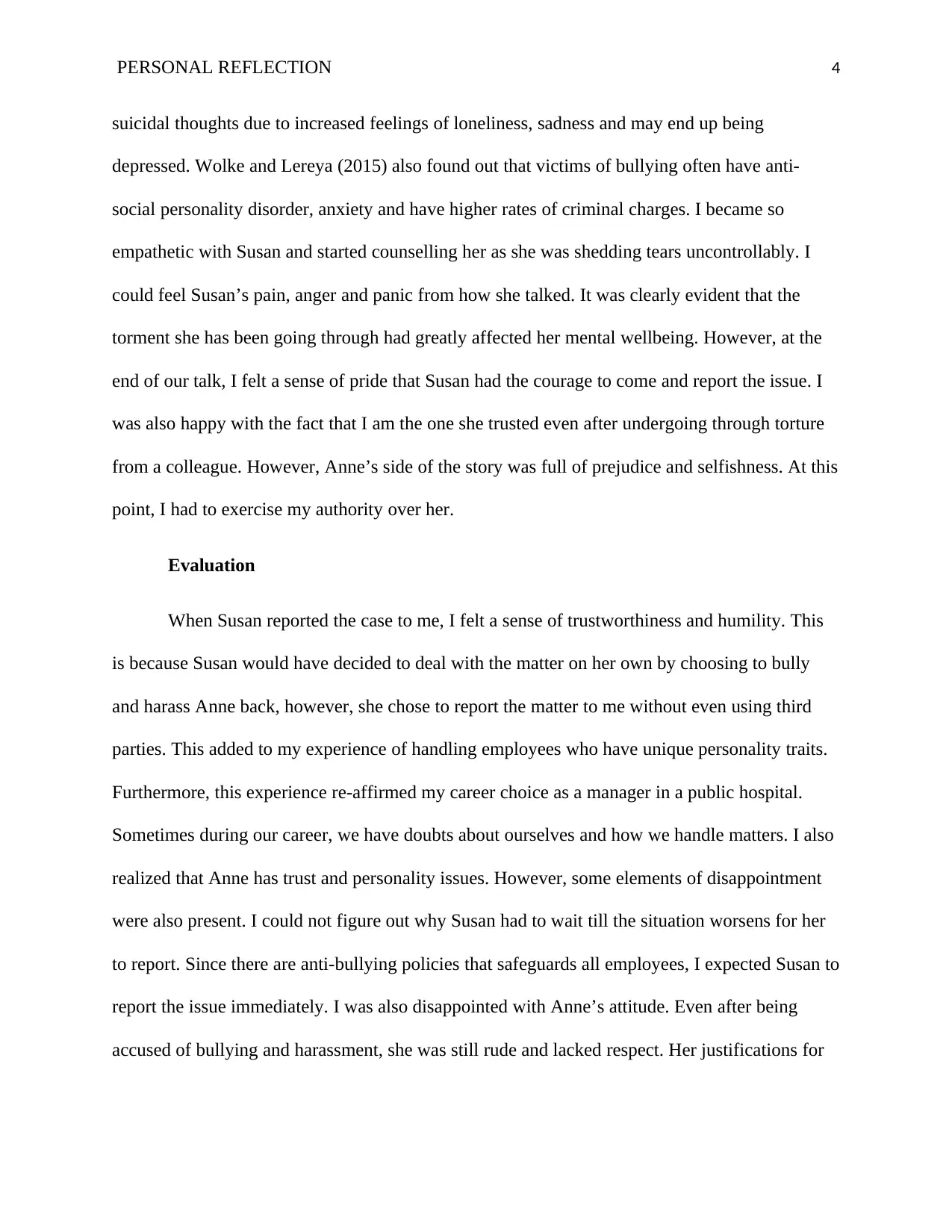
PERSONAL REFLECTION 4
suicidal thoughts due to increased feelings of loneliness, sadness and may end up being
depressed. Wolke and Lereya (2015) also found out that victims of bullying often have anti-
social personality disorder, anxiety and have higher rates of criminal charges. I became so
empathetic with Susan and started counselling her as she was shedding tears uncontrollably. I
could feel Susan’s pain, anger and panic from how she talked. It was clearly evident that the
torment she has been going through had greatly affected her mental wellbeing. However, at the
end of our talk, I felt a sense of pride that Susan had the courage to come and report the issue. I
was also happy with the fact that I am the one she trusted even after undergoing through torture
from a colleague. However, Anne’s side of the story was full of prejudice and selfishness. At this
point, I had to exercise my authority over her.
Evaluation
When Susan reported the case to me, I felt a sense of trustworthiness and humility. This
is because Susan would have decided to deal with the matter on her own by choosing to bully
and harass Anne back, however, she chose to report the matter to me without even using third
parties. This added to my experience of handling employees who have unique personality traits.
Furthermore, this experience re-affirmed my career choice as a manager in a public hospital.
Sometimes during our career, we have doubts about ourselves and how we handle matters. I also
realized that Anne has trust and personality issues. However, some elements of disappointment
were also present. I could not figure out why Susan had to wait till the situation worsens for her
to report. Since there are anti-bullying policies that safeguards all employees, I expected Susan to
report the issue immediately. I was also disappointed with Anne’s attitude. Even after being
accused of bullying and harassment, she was still rude and lacked respect. Her justifications for
suicidal thoughts due to increased feelings of loneliness, sadness and may end up being
depressed. Wolke and Lereya (2015) also found out that victims of bullying often have anti-
social personality disorder, anxiety and have higher rates of criminal charges. I became so
empathetic with Susan and started counselling her as she was shedding tears uncontrollably. I
could feel Susan’s pain, anger and panic from how she talked. It was clearly evident that the
torment she has been going through had greatly affected her mental wellbeing. However, at the
end of our talk, I felt a sense of pride that Susan had the courage to come and report the issue. I
was also happy with the fact that I am the one she trusted even after undergoing through torture
from a colleague. However, Anne’s side of the story was full of prejudice and selfishness. At this
point, I had to exercise my authority over her.
Evaluation
When Susan reported the case to me, I felt a sense of trustworthiness and humility. This
is because Susan would have decided to deal with the matter on her own by choosing to bully
and harass Anne back, however, she chose to report the matter to me without even using third
parties. This added to my experience of handling employees who have unique personality traits.
Furthermore, this experience re-affirmed my career choice as a manager in a public hospital.
Sometimes during our career, we have doubts about ourselves and how we handle matters. I also
realized that Anne has trust and personality issues. However, some elements of disappointment
were also present. I could not figure out why Susan had to wait till the situation worsens for her
to report. Since there are anti-bullying policies that safeguards all employees, I expected Susan to
report the issue immediately. I was also disappointed with Anne’s attitude. Even after being
accused of bullying and harassment, she was still rude and lacked respect. Her justifications for
Paraphrase This Document
Need a fresh take? Get an instant paraphrase of this document with our AI Paraphraser
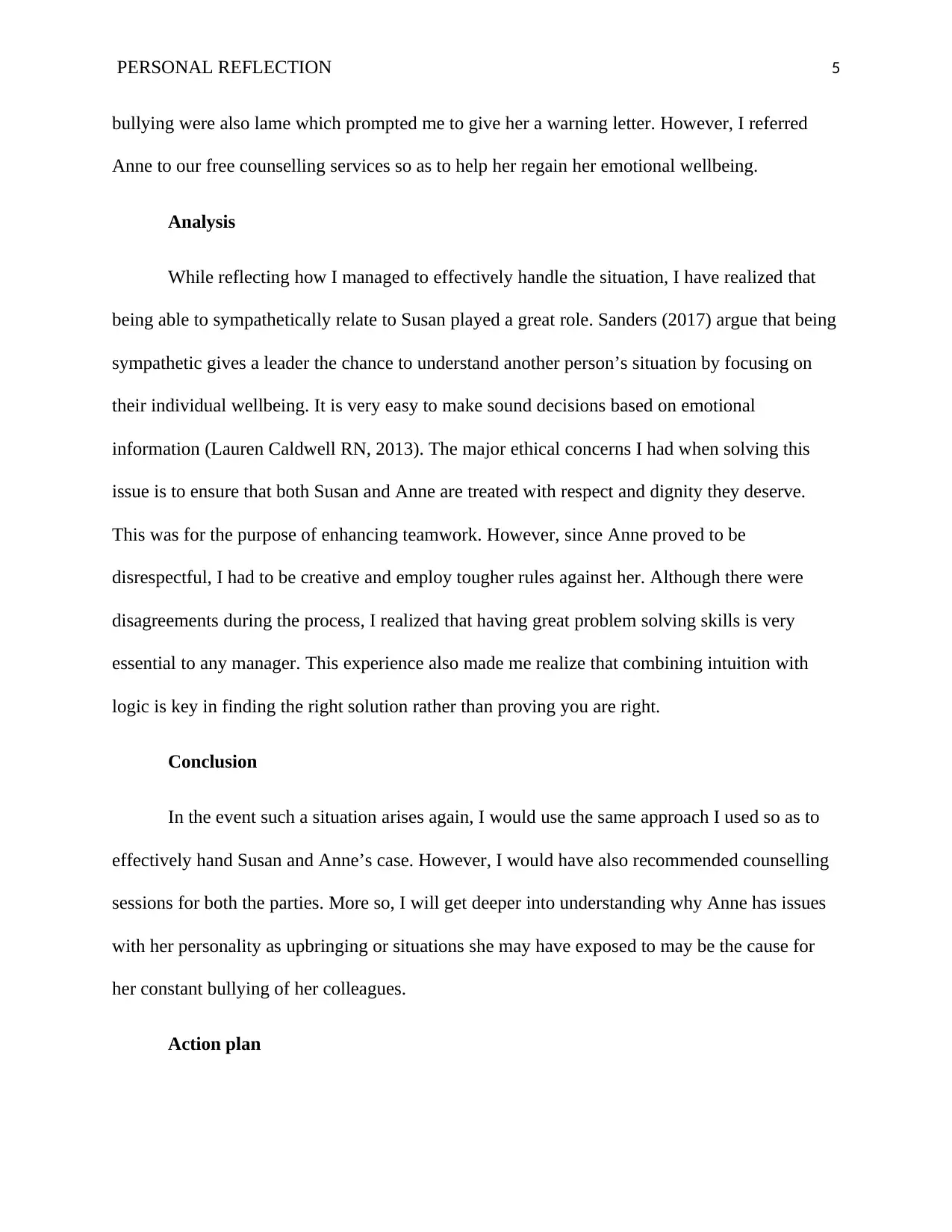
PERSONAL REFLECTION 5
bullying were also lame which prompted me to give her a warning letter. However, I referred
Anne to our free counselling services so as to help her regain her emotional wellbeing.
Analysis
While reflecting how I managed to effectively handle the situation, I have realized that
being able to sympathetically relate to Susan played a great role. Sanders (2017) argue that being
sympathetic gives a leader the chance to understand another person’s situation by focusing on
their individual wellbeing. It is very easy to make sound decisions based on emotional
information (Lauren Caldwell RN, 2013). The major ethical concerns I had when solving this
issue is to ensure that both Susan and Anne are treated with respect and dignity they deserve.
This was for the purpose of enhancing teamwork. However, since Anne proved to be
disrespectful, I had to be creative and employ tougher rules against her. Although there were
disagreements during the process, I realized that having great problem solving skills is very
essential to any manager. This experience also made me realize that combining intuition with
logic is key in finding the right solution rather than proving you are right.
Conclusion
In the event such a situation arises again, I would use the same approach I used so as to
effectively hand Susan and Anne’s case. However, I would have also recommended counselling
sessions for both the parties. More so, I will get deeper into understanding why Anne has issues
with her personality as upbringing or situations she may have exposed to may be the cause for
her constant bullying of her colleagues.
Action plan
bullying were also lame which prompted me to give her a warning letter. However, I referred
Anne to our free counselling services so as to help her regain her emotional wellbeing.
Analysis
While reflecting how I managed to effectively handle the situation, I have realized that
being able to sympathetically relate to Susan played a great role. Sanders (2017) argue that being
sympathetic gives a leader the chance to understand another person’s situation by focusing on
their individual wellbeing. It is very easy to make sound decisions based on emotional
information (Lauren Caldwell RN, 2013). The major ethical concerns I had when solving this
issue is to ensure that both Susan and Anne are treated with respect and dignity they deserve.
This was for the purpose of enhancing teamwork. However, since Anne proved to be
disrespectful, I had to be creative and employ tougher rules against her. Although there were
disagreements during the process, I realized that having great problem solving skills is very
essential to any manager. This experience also made me realize that combining intuition with
logic is key in finding the right solution rather than proving you are right.
Conclusion
In the event such a situation arises again, I would use the same approach I used so as to
effectively hand Susan and Anne’s case. However, I would have also recommended counselling
sessions for both the parties. More so, I will get deeper into understanding why Anne has issues
with her personality as upbringing or situations she may have exposed to may be the cause for
her constant bullying of her colleagues.
Action plan
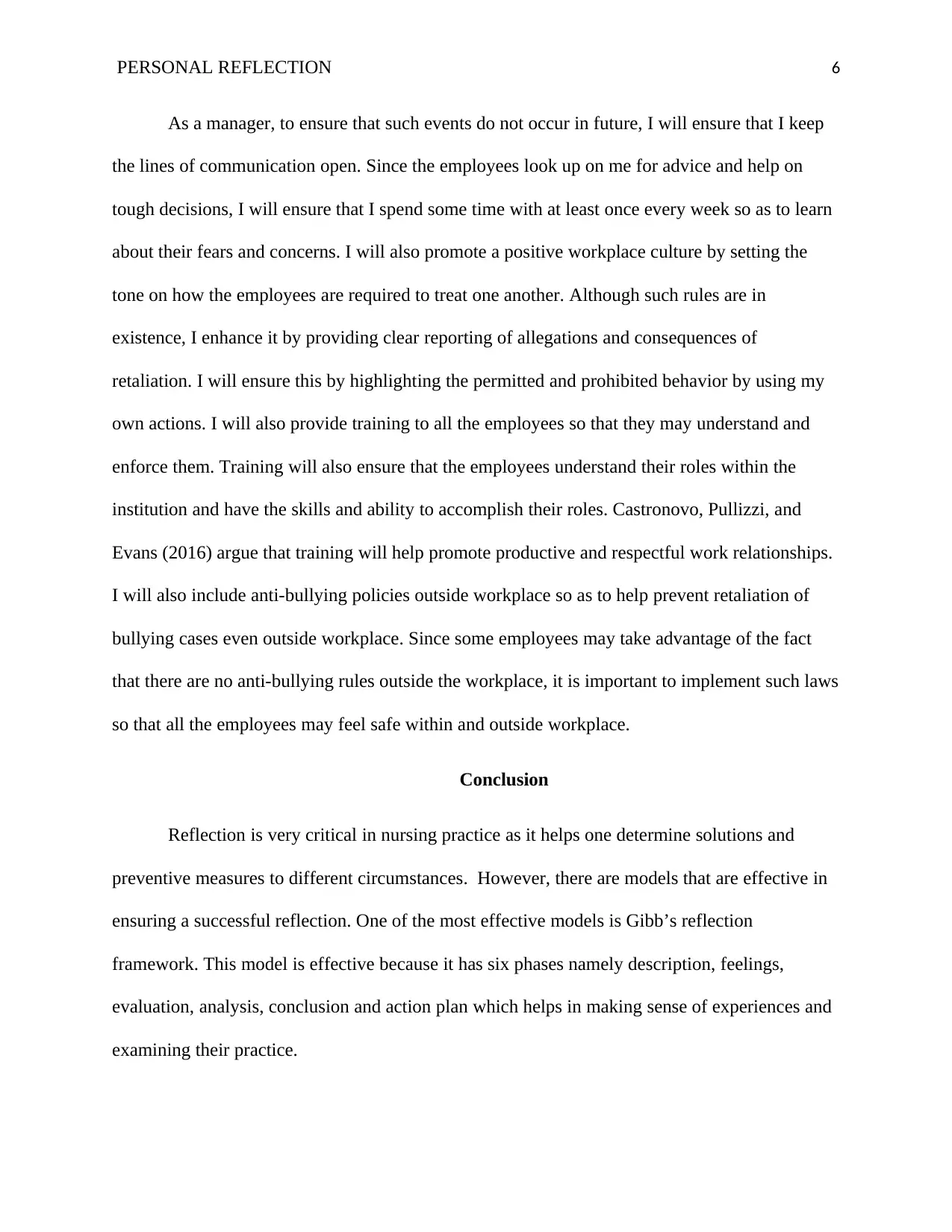
PERSONAL REFLECTION 6
As a manager, to ensure that such events do not occur in future, I will ensure that I keep
the lines of communication open. Since the employees look up on me for advice and help on
tough decisions, I will ensure that I spend some time with at least once every week so as to learn
about their fears and concerns. I will also promote a positive workplace culture by setting the
tone on how the employees are required to treat one another. Although such rules are in
existence, I enhance it by providing clear reporting of allegations and consequences of
retaliation. I will ensure this by highlighting the permitted and prohibited behavior by using my
own actions. I will also provide training to all the employees so that they may understand and
enforce them. Training will also ensure that the employees understand their roles within the
institution and have the skills and ability to accomplish their roles. Castronovo, Pullizzi, and
Evans (2016) argue that training will help promote productive and respectful work relationships.
I will also include anti-bullying policies outside workplace so as to help prevent retaliation of
bullying cases even outside workplace. Since some employees may take advantage of the fact
that there are no anti-bullying rules outside the workplace, it is important to implement such laws
so that all the employees may feel safe within and outside workplace.
Conclusion
Reflection is very critical in nursing practice as it helps one determine solutions and
preventive measures to different circumstances. However, there are models that are effective in
ensuring a successful reflection. One of the most effective models is Gibb’s reflection
framework. This model is effective because it has six phases namely description, feelings,
evaluation, analysis, conclusion and action plan which helps in making sense of experiences and
examining their practice.
As a manager, to ensure that such events do not occur in future, I will ensure that I keep
the lines of communication open. Since the employees look up on me for advice and help on
tough decisions, I will ensure that I spend some time with at least once every week so as to learn
about their fears and concerns. I will also promote a positive workplace culture by setting the
tone on how the employees are required to treat one another. Although such rules are in
existence, I enhance it by providing clear reporting of allegations and consequences of
retaliation. I will ensure this by highlighting the permitted and prohibited behavior by using my
own actions. I will also provide training to all the employees so that they may understand and
enforce them. Training will also ensure that the employees understand their roles within the
institution and have the skills and ability to accomplish their roles. Castronovo, Pullizzi, and
Evans (2016) argue that training will help promote productive and respectful work relationships.
I will also include anti-bullying policies outside workplace so as to help prevent retaliation of
bullying cases even outside workplace. Since some employees may take advantage of the fact
that there are no anti-bullying rules outside the workplace, it is important to implement such laws
so that all the employees may feel safe within and outside workplace.
Conclusion
Reflection is very critical in nursing practice as it helps one determine solutions and
preventive measures to different circumstances. However, there are models that are effective in
ensuring a successful reflection. One of the most effective models is Gibb’s reflection
framework. This model is effective because it has six phases namely description, feelings,
evaluation, analysis, conclusion and action plan which helps in making sense of experiences and
examining their practice.
⊘ This is a preview!⊘
Do you want full access?
Subscribe today to unlock all pages.

Trusted by 1+ million students worldwide
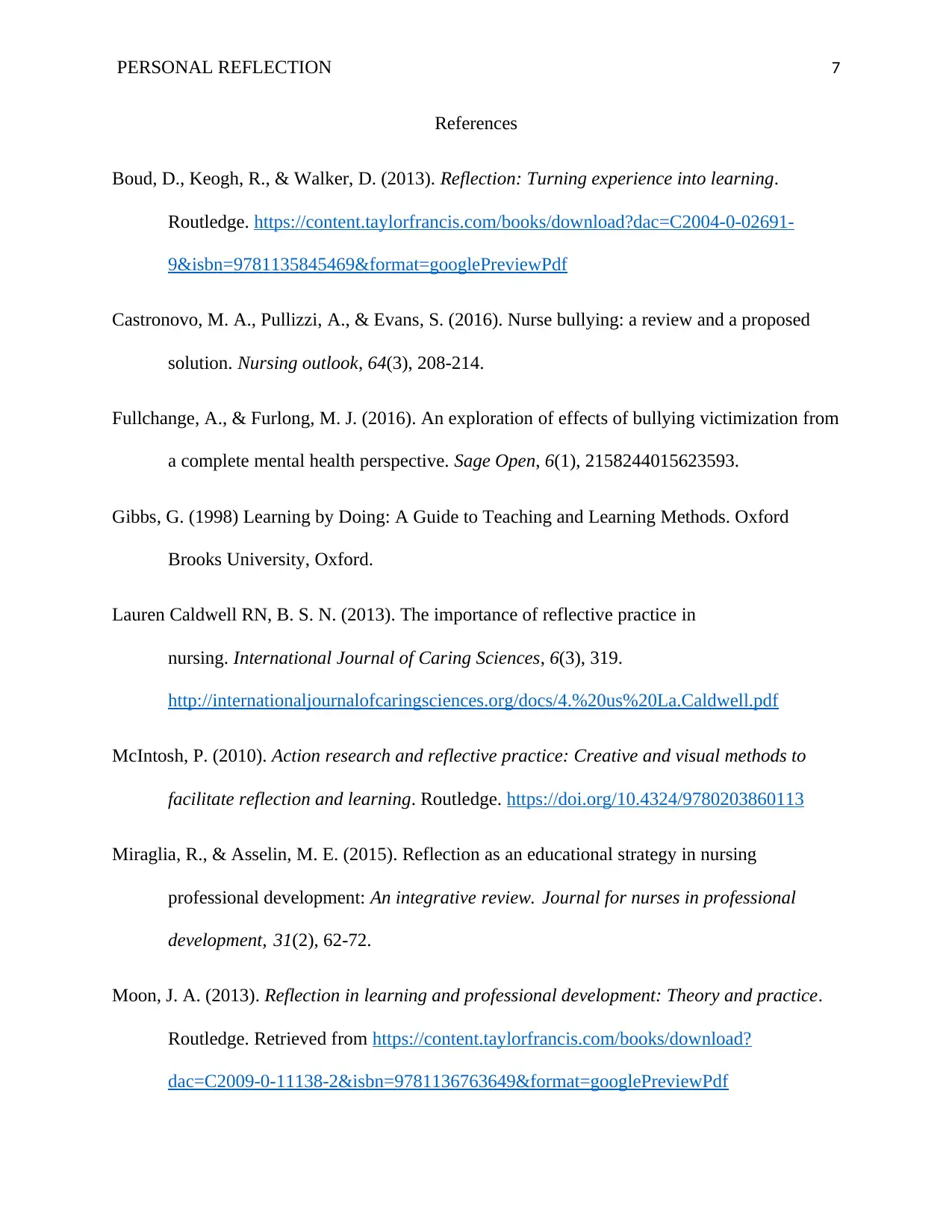
PERSONAL REFLECTION 7
References
Boud, D., Keogh, R., & Walker, D. (2013). Reflection: Turning experience into learning.
Routledge. https://content.taylorfrancis.com/books/download?dac=C2004-0-02691-
9&isbn=9781135845469&format=googlePreviewPdf
Castronovo, M. A., Pullizzi, A., & Evans, S. (2016). Nurse bullying: a review and a proposed
solution. Nursing outlook, 64(3), 208-214.
Fullchange, A., & Furlong, M. J. (2016). An exploration of effects of bullying victimization from
a complete mental health perspective. Sage Open, 6(1), 2158244015623593.
Gibbs, G. (1998) Learning by Doing: A Guide to Teaching and Learning Methods. Oxford
Brooks University, Oxford.
Lauren Caldwell RN, B. S. N. (2013). The importance of reflective practice in
nursing. International Journal of Caring Sciences, 6(3), 319.
http://internationaljournalofcaringsciences.org/docs/4.%20us%20La.Caldwell.pdf
McIntosh, P. (2010). Action research and reflective practice: Creative and visual methods to
facilitate reflection and learning. Routledge. https://doi.org/10.4324/9780203860113
Miraglia, R., & Asselin, M. E. (2015). Reflection as an educational strategy in nursing
professional development: An integrative review. Journal for nurses in professional
development, 31(2), 62-72.
Moon, J. A. (2013). Reflection in learning and professional development: Theory and practice.
Routledge. Retrieved from https://content.taylorfrancis.com/books/download?
dac=C2009-0-11138-2&isbn=9781136763649&format=googlePreviewPdf
References
Boud, D., Keogh, R., & Walker, D. (2013). Reflection: Turning experience into learning.
Routledge. https://content.taylorfrancis.com/books/download?dac=C2004-0-02691-
9&isbn=9781135845469&format=googlePreviewPdf
Castronovo, M. A., Pullizzi, A., & Evans, S. (2016). Nurse bullying: a review and a proposed
solution. Nursing outlook, 64(3), 208-214.
Fullchange, A., & Furlong, M. J. (2016). An exploration of effects of bullying victimization from
a complete mental health perspective. Sage Open, 6(1), 2158244015623593.
Gibbs, G. (1998) Learning by Doing: A Guide to Teaching and Learning Methods. Oxford
Brooks University, Oxford.
Lauren Caldwell RN, B. S. N. (2013). The importance of reflective practice in
nursing. International Journal of Caring Sciences, 6(3), 319.
http://internationaljournalofcaringsciences.org/docs/4.%20us%20La.Caldwell.pdf
McIntosh, P. (2010). Action research and reflective practice: Creative and visual methods to
facilitate reflection and learning. Routledge. https://doi.org/10.4324/9780203860113
Miraglia, R., & Asselin, M. E. (2015). Reflection as an educational strategy in nursing
professional development: An integrative review. Journal for nurses in professional
development, 31(2), 62-72.
Moon, J. A. (2013). Reflection in learning and professional development: Theory and practice.
Routledge. Retrieved from https://content.taylorfrancis.com/books/download?
dac=C2009-0-11138-2&isbn=9781136763649&format=googlePreviewPdf
Paraphrase This Document
Need a fresh take? Get an instant paraphrase of this document with our AI Paraphraser
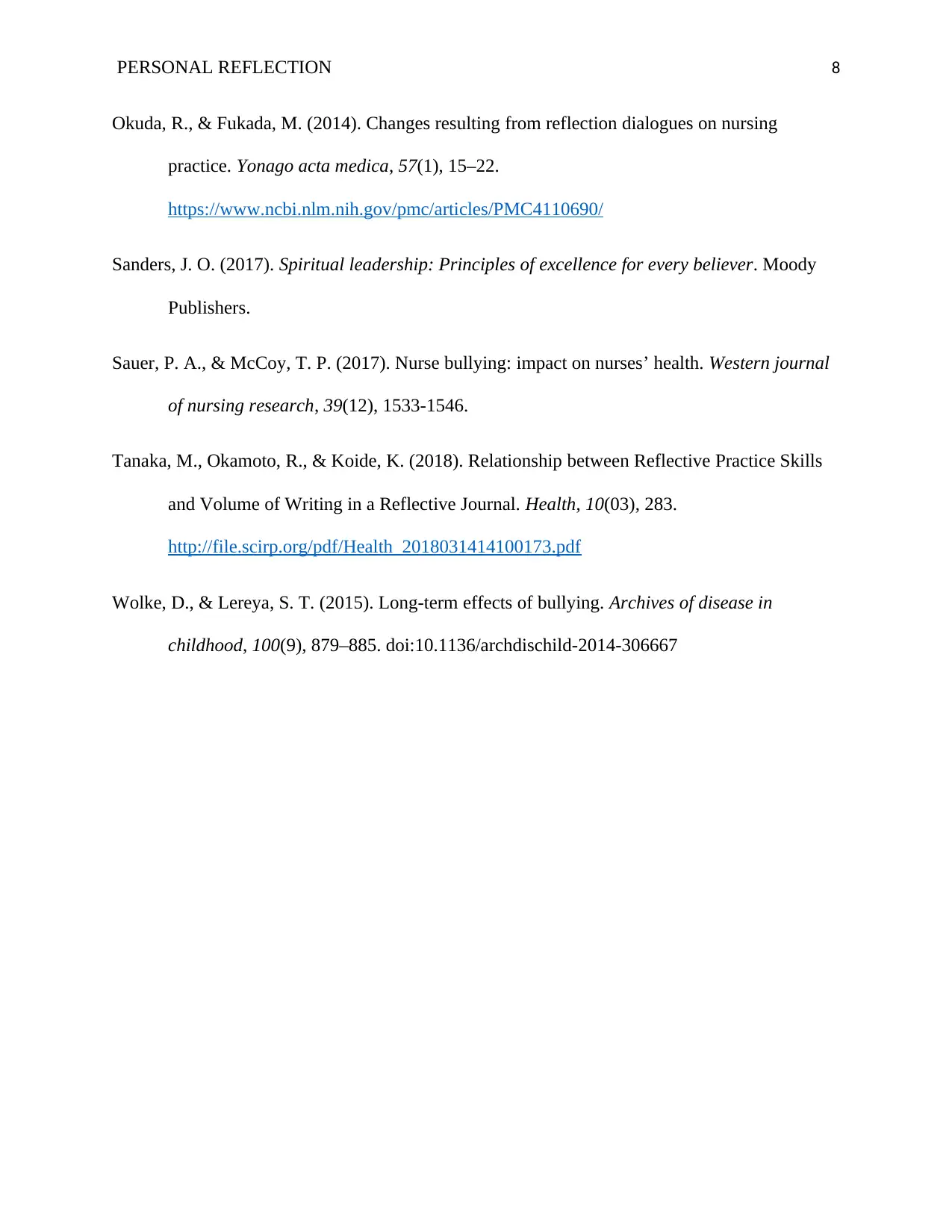
PERSONAL REFLECTION 8
Okuda, R., & Fukada, M. (2014). Changes resulting from reflection dialogues on nursing
practice. Yonago acta medica, 57(1), 15–22.
https://www.ncbi.nlm.nih.gov/pmc/articles/PMC4110690/
Sanders, J. O. (2017). Spiritual leadership: Principles of excellence for every believer. Moody
Publishers.
Sauer, P. A., & McCoy, T. P. (2017). Nurse bullying: impact on nurses’ health. Western journal
of nursing research, 39(12), 1533-1546.
Tanaka, M., Okamoto, R., & Koide, K. (2018). Relationship between Reflective Practice Skills
and Volume of Writing in a Reflective Journal. Health, 10(03), 283.
http://file.scirp.org/pdf/Health_2018031414100173.pdf
Wolke, D., & Lereya, S. T. (2015). Long-term effects of bullying. Archives of disease in
childhood, 100(9), 879–885. doi:10.1136/archdischild-2014-306667
Okuda, R., & Fukada, M. (2014). Changes resulting from reflection dialogues on nursing
practice. Yonago acta medica, 57(1), 15–22.
https://www.ncbi.nlm.nih.gov/pmc/articles/PMC4110690/
Sanders, J. O. (2017). Spiritual leadership: Principles of excellence for every believer. Moody
Publishers.
Sauer, P. A., & McCoy, T. P. (2017). Nurse bullying: impact on nurses’ health. Western journal
of nursing research, 39(12), 1533-1546.
Tanaka, M., Okamoto, R., & Koide, K. (2018). Relationship between Reflective Practice Skills
and Volume of Writing in a Reflective Journal. Health, 10(03), 283.
http://file.scirp.org/pdf/Health_2018031414100173.pdf
Wolke, D., & Lereya, S. T. (2015). Long-term effects of bullying. Archives of disease in
childhood, 100(9), 879–885. doi:10.1136/archdischild-2014-306667
1 out of 8
Related Documents
Your All-in-One AI-Powered Toolkit for Academic Success.
+13062052269
info@desklib.com
Available 24*7 on WhatsApp / Email
![[object Object]](/_next/static/media/star-bottom.7253800d.svg)
Unlock your academic potential
Copyright © 2020–2025 A2Z Services. All Rights Reserved. Developed and managed by ZUCOL.





